My favourite and most productive part of my garden: our small pond!
Jian Liu, from Camberwell, discusses her pond. In May 2021, Jian’s garden featured on Gardening Australia – watch the 7 minute segment.
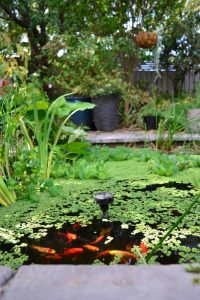
If you’ve never thought about growing edibles in a pond before, you should definitely give it a go! It’s easy and super productive. And it doesn’t even need much space. Think of it as a giant ‘self-watering’ pot which grows moisture-loving plants with no effort on your part, just place and forget.
I had never thought about having a pond before as part of a permaculture garden but I now think that it’s an essential part of our backyard ecosystem. With a few tweaks, we have managed to convert our green algae-filled pond, that has been a constant source of headache, into our favourite and most productive part of our garden – requiring no watering yet producing an abundance of food for us and nitrogen-rich materials for our compost, not to mention an absolute magnet for bees and beneficial insects! Sounds too good to be true?
A pond? But my garden’s not big enough!
You don’t need a big space at all to get the benefits from growing in water. Some people use a large flexi-tub that you can buy from the hardware store (or try hard rubbish), an old bathtub or wheelbarrow. When we moved in, we had a small existing pond around 2m x 2m square and about knee deep. It had around 10 goldfish, a water lily, and an underwater plant but, because of where it was positioned, it got lots of sunshine. The result? The water was always a green soupy mix filled with algae and we could barely see the fish, no matter how long we ran the fountain.
Our problem and journey to a solution
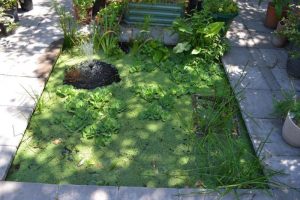
We used to change the water a few times a year which was always a huge ordeal. It would look good for a month or so and then quickly turn green again, even quicker in summer. It was not only time-consuming, but completely ineffective and unsustainable.
I sought out advice from many pond stores and was told various conflicting things: “you have too many fish for your small space and an excess of nutrients; you need to get rid of some” (by this time the fish had grown to around 20+), “your pond is too sunny; the only fix is to buy a UV filter” (which not only was expensive, constantly wasting power, but would also kill off any good bacteria in the pond).
Most recently, we were sold some algae tablets – which were simple and inexpensive, just drop two into the pond a few times a year and it would fix all of our problems. Indeed it did, within a matter of weeks all the algae was gone and I have never seen our waters so crystal clear! It seemed like a magical and easy solution – however, not long after, our water lily and the water lettuce started to suffer. I tried to salvage them but some didn’t make it. It was a good thing that the fish were not harmed. But it was quite disheartening – like we were forced to choose between clean water and no plants, or plants but putrid green water.
Our solution
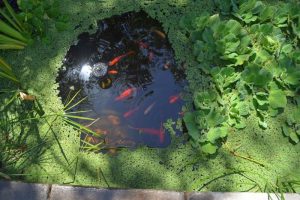
I thought there had to be a better and sustainable way, without sacrificing fish or using chemicals. I researched – borrowed every book on the subject, joined forums online and did lots of reading. The only solution seemed to be to fill the pond with a diversity of plants (to suck up all the excess nutrients from the fish poo) and ensure at least 40% of the surface of the water was covered with plants (to prevent too much sunlight getting in and causing algae to grow).
We gradually increased the plants in our pond – divided up our single lily into 4 plants, planted many more plants (which I list below) and, most importantly, managed to source a large batch of azolla (which you can see covering the surface of our pond in the photos) – I think that this made the key difference. Since then, our water has remained clear without any intervention from us and, despite our expanding fish population of now 30+, I only run the fountain occasionally. As we are on a journey to transform our garden into an edible permaculture food forest, we have also added in a variety of edible plants into the pond to make the most of our space.
My top 5 benefits of having a pond/water feature

1. Insects love it – nothing in our garden attracts more bees than our pond. In summer, it is visited by a never-ending stream of bees, dragonflies and other insects. And growing surface plants help insects to drink from the pond without falling in.
2. It is the best place for growing many edible water plants (read below). They don’t need any watering. You can go on holiday and not worry about them, they grow like weeds as they have a constant source of water, no matter how hot our days are. Also, I suspect the fish poo is a source of fertiliser for them.
3. I’ve read (and it seems logical) that ponds help cool the garden in summer by releasing moisture which provides humidity for plants; while, in winter, ponds store up warmth which is released at night. So, the area around a pond becomes a micro-climate that many plants love.
4. It can provide a never-ending and sustainable source of materials for your compost and mulch (refer to section on azolla below).
5. Because water is pretty and relaxing! Water, fish and a fountain provide a visual focal point in the garden and create a wonderful place to sit beside and just watch the fish swimming around.
My top plants to have in a pond
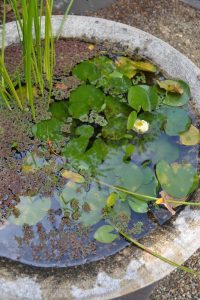
1. Azolla – an absolutely essential pond and permaculture plant, particularly if you have goldfish. Azolla is a fast grower and consumes all the nutrients produced by the fish, thereby depriving algae of any food to grow. It also covers the surface of the water and prevents the sun from getting in (sunlight promotes algae growth). The recommendation is to have at least 40% of your pond surface covered by plants. In our sunny spot in summer, I usually aim for around 80-90% coverage. Azolla is a super fast grower and also has the benefit of fixing nitrogen from the atmosphere. I scoop out a net of azolla into the compost every few days and it’s an excellent compost activator or even mulch. And it is also a good fish and animal food!
Azolla can be a smart idea even if you don’t have any fish. Its common name is ‘mosquito fern’, which is a reference to the fact that, when it covers the surface of a water, mosquitos are unable to lay their eggs in the water. Anything that stops mosquitos in the garden is always going to be a favourite of mine! The azolla has single-handedly transformed our pond into an ecosystem: the azolla grows rapidly by drawing out the nutrients in the excess of fish poo we have -> we then add buckets of azolla to compost -> our compost feeds our fruit and veggie plants -> that in turn feed us.
As Bill Mollison once said: “you don’t have a snail problem, you have a duck-deficiency“. In our case, our problem wasn’t an overabundance of fish but a deficiency of azolla and other pond plants.

2. Other ornamental plants that provide surface coverage, such as water lily and water lettuce – these look pretty (nothing beats the glowing bring pops of colour of water lily) and relaxing as they float on the surface of the pond, but they also shield the pond from sunlight. Water lettuce grows so fast that it’s even outcompeted our azolla! I purchased one plant and, four months later had 30. They grow from little babies that break off and form their own families. Water lilies need to be divided up regularly: one plant will become four, then eight, and so on (you’ll have plenty to swap with others).
3. Edibles – there are water versions of many of the plants we like to eat. I think that these versions are easier to grow as they’re happy as long as there’s enough water in the pond – this whole summer, I only topped up our pond twice. (Tip: if your pond is too deep, sit your plants up on a few bricks, plastic tubs or whatever you have to provide a platform for the plants.)
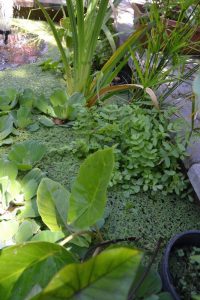
- Mint – I have never being able to grow mint well in normal soil or pots. Either the soil is too low in organic matter or I just don’t water it enough. In the pond, it’s a different story – the mint grows with no effort. I successfully grow many varieties, including apple mint and peppermint. I also grow Vietnamese mint.
- Watercress – as you might guess, watercress loves water. I’m growing two types: standard sandwich watercress and lebanese watercress (which has lovely fern like leaves). I’ve seen lebanese watercress marketed as ‘carrot plant’, as it does taste a lot like carrot, and it adds a wonderful pop of flavour to any salad or stir fry.
- Water chestnut – this has been my first season growing these and they’ve really taken off! It looks like a pretty water reed and all you do is bury them into compost enriched soil, and plonk the pot into the pond and it grows and grows. It is said that each corn can produce over 200 corns, so I’m looking forward to lots of sweet water chestnuts for salads and stir fries. They also freeze well so they can be used all year round.
- Water spinach – also known as ‘kang kong’ is used in stir fries in Asia. It only grows well in warm weather and I plan to give it a go in spring.
- Water parsley and water celery – I haven’t tried these yet. Water celery looks pretty with variegated leaves, and apparently tastes like a mild version of normal celery.

4. Other ornamental marginal/bog plants – to create more height and texture in our pond, we’re also growing a number of ornamental bog plants around the edge, including water papyrus, water lily, flowering water iris and elephant’s ear.
5. Oxygenating plants – as their name suggests, these are plants that grow under the water to help provide oxygen to the fish. I’ve read that their ‘oxygenating-effect’ is overrated and that the fountain is more effective, but it doesn’t hurt and they provide a good hiding place and rich underwater ecosystem for the fish. We have elodea and ribbon plant (vallisneria), which are common and fast growers.
And there you have it – our water wonderland! I hope that reading about my journey inspires you to add a pond or water feature to your garden or, if you already have one, gives you some ideas about how to make it work for you.
If you’d like to follow us on our journey to create an edible permaculture food garden, you can find us at www.instagram.com/melbourne.foodforest, where I post regularly.

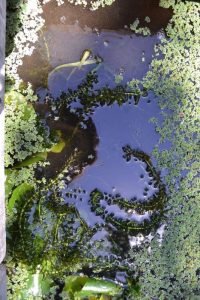

Hi Jian,
Thanks for the article. Where do you buy azolla and watercress? thanks.
Kwong
When in season, you can buy azolla online from many websites, including at https://www.ozwatergardens.com.au/plants/azolla/. Ditto watercress. Some nurseries also stock watercress.
Hi this is a really interesting article about what works and what doesn’t, thanks so much.
I have a solar fountain that I bought on eBay for less than $20 and it is marvellous. I don’t use the nozzles that came with it as it sends the water too high and then the water splashes everywhere and is wasted. The little solar panels are positioned around the water outlet.
It is marvellous and goes all the time when the sun is out and even when it is overcast. I am really using it as a water aerator. The only time it has stopped was when some slime got stuck in the motor part, but it was easy to remove and was working again very quickly.
I believe this may deter mosquitoes as the water splashing down would stop the adult from laying her eggs in the pond and interfere with how the larvae get air through the miniscus.
Thinking of starting a small pond garden using a garden pot for my balcony and adding some fishes. What fishes will thrive in Melbourne’s wintery weather? Thinking of guppies but afraid they might die in the cold weather.
Hi Jian, Before your pond ecosystem became balanced and self supporting, did you feed the fish with store-bought fish food? And are certain soils and plant fertilisers in the submerged pot plants harmful to the fish? Thanks, Lyn
Hi Lyn
Good questions. We still to a large extent feed our fish with store-bought food as our pond does not have enough food to support such large numbers of fish. Natural options to feed fish include those pesky cabbage white butterfly caterpillars and, of course, the fish will also naturally eat any mosquito larvae in the pond. However, depending on how many fish you have, you are likely to need to top up with fish food.
In terms of soil, I would limit what you put in and advise you to use garden soil, heavy on clay. I wouldn’t use potting mix as it’s too light. Also, there’s no need to add a lot of fertiliser, as it could pollute the pond and cause algae growth. Plus your fish poo will naturally fertilise the plants. We have once in the past fed our water lilies with special purpose water tablets (which you insert deep into the soil) with no adverse effects to our fish. I have not found any plants are harmful to the fish. They seem to know what to eat and what not to eat.
Cheers
Jian
Thanks so much Jian. This is the most helpful and practical info on edible pond plants and fish. Will be giving it a go!
Thanks for your very good article.
You have stated that azolla fix nitrogen from air to water. If that is the case then the pH of the water in the pond will rise and it won’t be suitable for the fish. My question then is: how is this nitrogen fixing property not able to affect the fish in your pond?
Hi Emmanuel, I have not heard of or experienced azolla increasing the pH of the water. Any nitrogen that it fixes is held in the plant itself, it is not dissolving into the water.
If azolla were able to mildly increase pH (which I certainly haven’t found it to) then this wouldn’t necessarily be a bad thing as rain water is somewhat acidic, and it would in fact counteract the mildly acidic conditions caused by rain and contribute to a healthier pond.
Cheers Jian
Jian, Emmanuel, this reply is a year late. Sorry.
The nitrogen is taken in by symbiotic bacteria that live within azolla leaf cavities. So, while azolla is alive, nitrogen is fixed within protein molecules.
Some azolla material underneath naturally dies. This then drops to the bottom, adding to the mud. Here nitrogen is released from decaying tissue. Nitrogen creates ammonia and nitrates, becoming available for takeup by other plants.
If duckweed (lemna, not azolla) is present in the pond then it will benefit from that extra nitrogen. The same for watercress.
I hope this information is helpful.
Thanks for the great information! Do you still need to use a filter and pump? How do you manage the fish population if there are too many?
Thanks Lyn, glad you found it helpful. If you are careful you can do away with a pump and filter entirely. We pretty much don’t run ours at all, but it can be a good fail safe to have one in the pond just in case e.g. if some of your under water plants might die back in winter because the water temp gets too low, rotting plants can dirty the water causing algae to grow – or if you have run off from pots and garden beds near the pond, that can contaminate the water with too much nutrients and result in short bursts of algae growth. In these cases, it can help to run the pump for a few days to get things back to a healthy equilibrium.
Easy way to manage too many fish is to just give some away 🙂 Although I find that fish naturally self-regulate based on the amount of food available, so you could also cut back feeding.
Ah that makes sense, thanks! Before your pond ecosystem became balanced and self supporting, did you feed the fish with store bought fish food? And are certain soils and plant fertilisers in the submerged pot plants harmful to the fish?
Thinking of starting a small pond garden using a garden pot for my balcony and adding some fishes. What fishes will thrive in Melbourne’s wintery weather? Thinking of guppies but afraid they might die in the cold weather.
Thank you for your article. I found it very informative. My small pond has been pea soup green for so long; now, thanks to your article, it will hopefully be on the road to recovery.
Thanks, Margy
Thanks Margy, I’m glad you found it helpful! I hope your pond has left its pea soup days behind and is now embracing crystal clear waters. Cheers, Jian.
Hi Jian,
Thank you for your article and replies to questions. It has confirmed some of my observations about Azolla and given my more information. For me, making a pond and keeping fish was a pandemic lockdown activity in 2020. I am now hooked and have just bought another pond. I am interested in growing more edible plants in my new pond. I live in South Gippsland so buying edible water plants is not impossible but a little difficult. I am especially looking to grow cress and water chestnuts. Are you able to supply me with these via the post? Thank you again for your informative article. Anne
Hi Anne – that’s great to hear about your pond passion! They are certainly addictive and rewarding. Unfortunately these types of plants would be difficult for me to post but I’m sure there are some great nurseries near you that will stock them. Or if ever you make a trip to Melbourne, feel free to get in contact. Cheers.
Hi Jian,
This year I discovered azolla and in has been amazing. I installed my kidney shaped pond about 20 years ago and it soon became the local hangout for brown tree frogs. The azolla solved many problems but now most of it is going brown and dying. I am wondering if this will contaminate my pond and thus harm the tadpoles(?) I do continuously remove the azolla but there is an amount that I can’t get to easily plus I do not want to harm frog eggs that are attached. Mainly I am worried it will contaminate the water(?)
Hi Lyn,
I’m so glad you have enjoyed all the benefits of azolla for ponds! If it is going brown and rotting then yes it will contaminate the pond a little – although the impact will depend on how many other plants you have. This happened to us for a short while too, when I stopped feeding our fish altogether and their population was also going up. I noticed that the fish were eating all the roots of the azolla hence causing it to brown off and rot. I decided to start feeding the fish again a bit each day and the azolla recovered instantly. Do you know what might be causing the azolla to go brown? I’m guessing you have creatures eating it in the pond. If so, perhaps a start might be to discourage them from doing so by planting other food sources for them. It could be just a short term issue until a new equilibrium is created.
The good news is that, even when our azolla went brown and rotted a bit, it didn’t cause a deterioration in our pond water because of all the other plants we have so, if you don’t already, I would recommend filling your pond with lots of diverse water plants. If you already have lots of plants then I wouldn’t worry too much about scooping out all the brown azolla. There will be enough plants to help suck out the nutrients from the decomposing azolla and keep your water clean.
Hope that helps!
Thank you for sharing your work, Jian! I work at a farm where we are trying to grow azolla in large quantities to add to our compost and animal feed. We have been experimenting with various locations on the farm. It seems that azolla likes dappled shade to some degree, but other bins of our are completely exposed to sunlight and do okay. Have you had any issues with the azolla browning out or dying, or do you feel like your shade coverage keeps it lush and healthy most of the time? Do you ever find that you need to replace your azolla or deal with any algae blooms in the azolla? And do you find that any of your other plants outcompete the azolla? Curious about the idea of diversifying our azolla pond and adding new plants to it to encourage more effective natural pond maintenance. Thank you so much!
Hi Paloma,
Azolla sounds like a fantastic component to incorporate into a farm system for compost and animal feed! I do find that our azolla planted under full sun turns pink, which looks great, but I haven’t had it browning or suffering even in our 44 degree heat. I’ve always read that it loves the sun, so I’m guessing it’s due to something else. Do you keep fish in the pond too? Could it potentially be from lack of nutrients in the water and it’s not growing as strong and vigorous?
None of our other pond plants grow nearly as fast as the azolla, the only one that comes close is the lebanese watercress! There’s a good head-to-head between the azolla and watercress every year. I don’t think I could declare a winner 🙂 I would highly recommend adding a variety of both underwater plants (eg elodea, ribbon plant), floating plants like azolla or water lily, and also marginal bog plants like lebanese watercress, umbrella sedge or water iris. It creates a lovely environment and also a great pond ecoystem.
After introducing azolla and all the pond plants, we’ve never had any issues with algae at all which is fantastic, and that’s with not running the fountain at all and not having a filter. If you are still getting algae it suggests to me that there are still not enough plants to absorb all the excess nutrients, so time for more plants!
I’d say don’t give up on the azolla. It is super tough and should take off and take over if you keep trying. It took about 3 goes before I established elodea in my pond – I kept buying it from aquarium places and it would just rot in our cold outdoors pond water. I eventually bought it from a pond shop and it is now taking over underwater in the pond!
Hi Jian
Great read! Re the watercress and water chestnuts, do they need to be rooted in substrate? And do you know where is the best place to source these delicious goodies from?
Thanks a bunch 🙂
Lulu
Hi Lulu,
The water chestnut will certainly need to be planted into soil – if you have soil at the bottom of your pond then you can plant straight in. I plant mine in pots. The larger your pots the more water chestnuts you will get.
The watercress is also best started in soil to provide it with a strong foundation. Having said that, it will eventually spread across the pond and float at the top, I’ve noticed when bits break off they still grow well as individual plants, so it could be possible to just float it on the pond.
Bulleen Art and Garden nursery sell both, although water chestnut is only at certain times of the year. I also sell them as well as other pond plants if you need any.
Cheers
Jian
Really helpful article – thanks so much for sharing!
Hi Jian Liu
Can you give us an idea of the size of your pond?
Can your system be scaled up to convert a swimming pool for fish and plants?
It’s 2m x 2m square and around 60cm total depth, although the water is rarely filled up to the top. Yes, from what I’ve observed, if you are converting a swimming pool to a fish pond it’s absolutely essential to have lots of plants otherwise your pond will be green even with a pump and fountain. A friend of mine converted their swimming pool into a pond and I’m encouraging her to write an article about the process 🙂
Thanks. Great article.
I have a small fish pond with goldfish and am interested to try. May I know where to get the supply of the top plant i.e. edible and oxygenating plants?
Thanks George! You should definitely get some edible plants, especially with goldfish – their poo is a great fertiliser for water plants.
Most nurseries, e.g. Bulleen Art and Garden, have a good supply of water plants, including edibles. Or you’re welcome to contact me I always have some for swapping.
Thanks so much for your article. We have a 600L pond in the backyard covered in Azolla that I also harvest for mulch and compost. Water Ribbon (Triglochin) is in the pond too as is a pot of Curly Sedge with some Watercress along the edge. No mozzie problems and just a small solar powered pump to provide some water movement. All growing well.
Great article – thanks.
Thanks Marina and for the suggestion to write it the article! 🙂
Are you using a pump or a filter to keep the pond oxygenated?
Yes, we have a pond fountain pump, as you may be able to see in the second photo – it has a large sponge under the water which acts as a filter.
We rarely run it now since introducing all the plants – probably around 20 minutes per day (and only in off-peak solar times) – because we just don’t need it anymore to keep the pond clean. And also to save power, plus water lillies don’t like water being constantly splashed on the leaves. The plants do the cleaning and oxygenating.
Before having the plants, we used to run it 10 hours+ a day and the water would still be green!
Jian, I purchased some azolla, put some in my fish pond, but it was sucked into the filter. So what do I do to get it to grow before placing into fish pond?
Hi Cheryl,
The azolla should be floating on the surface of the pond so it shouldn’t get sucked into the filter (which is positioned on the bottom of the pond). I’ve actually never heard of that happening before. Ours has a huge sponge attached to it so doesn’t suck in any fish or large pieces of things like azolla, and also it doesn’t draw anything from the surface. Perhaps check the calibration of your filter?
Wow, Jian, very inspiring. Thanks so much for sharing all this info, I have a couple of ‘water holes’ I’ve set up around the place for the critters of the wild and I’m trying to grow some other type of weed on top of the water (round leaves) but it doesn’t grow faster than the goldfish can eat it. I’ve googled Azolla and it’s in fact a very amazing plant – any idea where I can get some from?
Cheers
Nadege
If they are small round leaves, I think you might be talking about duckweed. That’s another water surface cover similar to azolla, but doesn’t have the benefit of fixing nitrogen. It looks pretty though!
With the plants that fish like to eat, you do need to start off with a substantial amount, otherwise it will all be gobbled up by the fish and disappear! And another a trick is to introduce any new plants just after you’ve fed the fish – then they won’t show too much interest in your new plant.
I initially bought a small amount of azolla online and it basically all disappeared when I put it in the pond (the fish might have eaten it and/or it dispersed). It’s only when I got a much larger amount off someone locally that it really took off. You’re welcome to contact me if you like some azolla 🙂 otherwise have a look online for someone nearby.